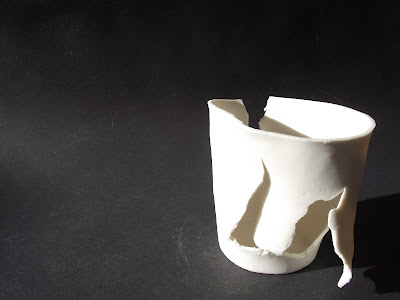Anyway I put them in the kiln and this was the result...
The latter ones are a combination of torn, dropped and water eroded ones. I felt as if I had to try these out on a larger form. I decided to cast one of the green plastic bowls from the plaster studio in ceramics. This was due to its sophisticated yet still simple form. The green bowl has a small foot on which lifts the curved form up off the surface it sits on just enough to give it a more elegant and uplifted overall feel. I cast one of these (as with everything else I had done so far; in porcelain) and then used the same water erosion technique on the rim of that form.

This form gives a far more refined look to the bottom half of the form, and using that in conjunction with the roughness and breakdown of the water erosion technique really seems to work. I feel that when cast in porcelain, the smooth form looks so plain and elegant, and the eroded section exposes the inside of this 'perfect' clay wall, creating not only a window into the clay body, but creating a tension between the two textures.
I want to accent this broken down texture. To do this I will explore the use of oxides and slips in the water that the form breaks down in.



















































